John Ball — January 21, 2015
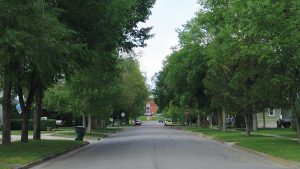
Landscaping too often focuses on the new. Every winter gardening publications highlight the up-and-coming “new and improved” tree cultivars. Glossy displays hype thevirtues of these latest trees: faster growth, better color, nicer form. Nursery sales representatives at trade shows expound on the merits of their new exclusive cultivars; they are guaranteed to increase your sales! Garden centers and landscapers join this feeding frenzy and order these trees to stock their stores and fill their landscapes, while at the same time discarding last year’s “new” trees. We all enjoy seeing new things—oh, how we anticipate the new car models every fall! —but this approach to tree selection may be leading us down a road we don’t want to go.
This is not a blanket judgment against new cultivars. Many do provide added value in better floral display, autumn foliage color or increased pest resistance. However, we seem to be focusing on creating more and more cultivars of fewer and fewer species. Really, how many new cultivars of red maple (Acer rubrum) do we need? We have divided that pie quite enough; we need to look elsewhere.
If we don’t, our ornamental trees may go the down the path we once thought the dinosaurs took, becoming more specialized until they become extinct from a catastrophic change in their environment to which they cannot adapt. What change might this be? Another comet or asteroid hurtling down from the heavens? No, nothing that dramatic. All we need is another pest to drop in.
Threats old and new
I imagine everyone reading this is aware of emerald ash borer (Agrilus planipennis) and its impact on ash in North America. While this small beetle has been devastating to communities that relied too heavily on ash (Fraxinus), it is not the first time we have dealt with the widespread loss of a tree due to an exotic pest. We have experienced several tree pandemics over the past century, and unless we ban international trade and travel (highly unlikely events), we will experience more in the future.
People are justifiably concerned about the loss of ash in North America, but this is nothing compared to the earlier impact of chestnut blight. More than 100 years ago, American chestnut (Castanea dentata) was the most common tree of the eastern deciduous forest. Chestnuts were so numerous it was said that a squirrel could jump chestnut to chestnut from the Atlantic to the Mississippi. Well, maybe a flying squirrel, but you get the idea: There were a lot of them.
That is, until chestnut blight showed up in New York. The year 1904 is often given as the starting date, but just as emerald ash borer was present in the Detroit area perhaps a decade before it was discovered, so was the case with chestnut blight. Reports of dying chestnuts began appearing a decade or more earlier, but in 1904 the decline was linked to a fungus and within another decade it was determined that the pathogen, what we now call Cryphonectria pasasitica, was previously unknown to this continent. It was later discovered that the fungus naturally occurred in East Asia, where it was a minor disease of Chinese (C. mollissima) and Japanese chestnut (C. crenta).
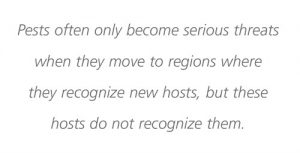
Unfortunately it did not prove to be a minor pest for American chestnut as the disease spread throughout its natural range by the 1950s. Except for sprouts that continue to grow, only to become infected and die back, and an occasional tree that has escaped infection, this species is gone from the forest.
A similar fate was to befall American elm (Ulmus americana). Once considered the ideal city tree, tough and fast growing, it populated many Eastern and Midwestern towns until Dutch elm disease (Ophiostoma ulmi) appeared. Dutch elm disease, having Asian origin despite the name “Dutch,” arrived from Asia via Europe where the disease was first noted. Once again, a disease that was only a minor pest in its homeland became a tree-killer when set loose on new trees in new lands.
The author communes with an amur chokecherry at the Baishilazi National Nature Reserve in China’s Eastern 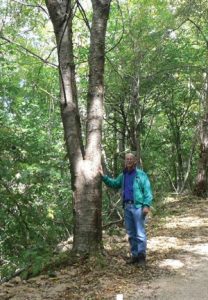 Liaoning Province.
Liaoning Province.
The closely related pathogen Ophiostoma novo-ulmi appeared in the 1940s and was even a more aggressive tree-killer in Europe and North America. European elms suffered tremendous losses from Dutch elm disease, and populations of our North American elms have also been significantly diminished.
The lesson we learned from Dutch elm disease was this: Do not plant elm. A little misguided advice as everyone just switched to another tough, fast growing tree—ash—and ash began to dominate the landscape. Green ash (F. pennsylvanica) became the big seller at the garden centers I worked at in the early 1970s. People loved it. The fast growth was considered “instant shade,” and it seemed to grow in almost any urban soil.
With popularity come cultivars, that rapid drive to become more specialized, and new cultivars of white (F. americana) and green ash began to appear almost every year. Some grew a little faster, or a little taller, or had better form or fall color and even variegated leaves, but they were still ash. Remember going through a nursery catalog in the 1990s? There were pages and pages of ash cultivars. Not any longer: You might find a half dozen, if you find any at all. Emerald ash borer changed all that.
Again, we learned the wrong lesson from Dutch elm disease (not to plant elm) and instead should have taken it as a call to diversify, not to put all our eggs into one basket. Unfortunately with emerald ash borer we have merely shifted our eggs into a new basket, this one Freeman maples (Acer × freemanii). This is another fast-growing tree—apparently speed is still the number one consideration for tree selection—and I see this tree going into new developments as fast as ash once did.
Just look how the cultivar list of Freeman maples has grown over the past decade. There are as many Freeman maple cultivars on the market now as there once were ash. Wait till we wake up one morning to find that a newly discovered insect from Asia, a minor pest of maples there, is doing to maples here what its cousins, chestnut blight, Dutch elm disease and emerald ash borer, have already done to our native trees. True, we have Asian longhorned beetle (Anoplophora glabripennis) here, but this insect has not caused the widespread loss of maples as emerald ash borer has done to ash. We had better start diversifying, but how?
Common hoptree (Ptelea trifoliata), seen here on the campus of North Dakota State University in Fargo, is native to 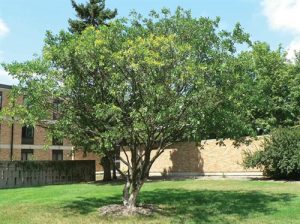 North America. We have little to fear from planting more of this tree, as least as far as exotic threats are concerned; no one is out there.
North America. We have little to fear from planting more of this tree, as least as far as exotic threats are concerned; no one is out there.
Improving on the 10-20-30 rule
Back in the late 1980s, Dr. Frank Santamour Jr., then a research geneticist with the U.S. National Arboretum, proposed the 10-20-30 formula for diversity in the urban forest, limiting the plantings in a community to no more than 10 percent within a single species, 20 percent within a genus and 30 percent within a family. This formula has guided many in their diversity efforts, and while it is a good start, it does not go far enough. Dutch elm disease does not affect just American elm, but our other native elms species, as well. Emerald ash borer does not just infest white ash and green ash, but all our other native ash species (though apparently blue ash [F. quadrangulata] is showing some tolerance). A 10 percent limitation to species means that if a community had 10 percent of its trees white ash and another 10 percent green ash, they still could potentially lose 20 percent of their trees to emerald ash borer.
What we need is more genera. I propose no more than 5 percent of a community’s trees be in one genus. This, in itself, may not reduce the possibility of an exotic threat, but will limit its impact. If only 5 percent of a community’s trees were ash, emerald ash borer would be a more manageable problem and would not be draining the resources to the degree it is in cities where ash was 25 to 30 percent of the population.

The 5 percent rule will be tough to achieve, and may not always be possible, but there are some genera for which you might want to follow the rule as closely as possible. These include ash, elm, linden (Tilia), oak (Quercus), maple, pine (Pinus), poplar (Poplar) and spruce (Picea). Why these genera? What do they have in common? They all have many species spread across the three northern continents— Asia, Europe and North America. Some, such as oak, even reach into Africa and South America. Geographical barriers, such as oceans, mountains and deserts, have isolated species in these genera into distinct populations within their own continents, each contending and co-evolving with their own unique pests. We already have experienced the repercussions of this pattern with ash and elm; the rest may follow, as this pattern of isolated populations is the set-up for lethal exotic pests.
The problem with emerald ash borer in North America is that the beetle recognized our native ash species as suitable hosts, but our species have no defenses against it. This highlights an important point: Pests often only become serious threats when they move to regions where they recognize new hosts, but these hosts do not recognize them. The new hosts have never developed the defenses from them, there being no need, but they are still hosts. We are taking a chance, as we did with ash and elm, when we overplant, not realizing that pests that might come from another continent with its own ash and elm species.
What’s the exception?
Any genera for which we might be able to push the percentage a little higher? Yes. There are native genera that have 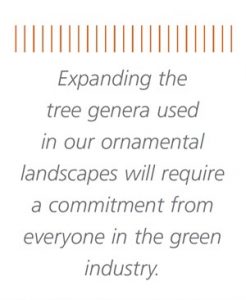 no or very few overseas cousins. Common hoptree (Ptelea trifoliata), often called wafer-ash, is native to North America. It, and the other three related species (considered by some to be subspecies of common hoptree), share more in common than a genus, they share the same continent. There are no cousins elsewhere. We have little to fear from planting more of this tree, as least as far as exotic threats are concerned; no one is out there. There are probably very few exotic pests that would recognize it as a suitable host.
no or very few overseas cousins. Common hoptree (Ptelea trifoliata), often called wafer-ash, is native to North America. It, and the other three related species (considered by some to be subspecies of common hoptree), share more in common than a genus, they share the same continent. There are no cousins elsewhere. We have little to fear from planting more of this tree, as least as far as exotic threats are concerned; no one is out there. There are probably very few exotic pests that would recognize it as a suitable host.
I realize that there is a lot of work ahead to refine the characteristics of hoptree; flowers can range from fragrant to stinky, and some plants are more treeform than others. While we have a few cultivars of hoptree, our efforts to expand the offering of this species are probably better insurance from future tree pandemics than creating another red maple cultivar.
Even trees such as Kentucky coffeetree (Gymnocladus dioica) are relatively safe bets. There are only a few other species in the genus, mostly in southeastern Asia, with the Chinese coffeetree (G. chinensis) the most common but still having only a limited natural range in China. Coffeetrees have relatively few pests and are not likely to have them move.
The other possibility is genera that are limited to Europe or Asia. We are not likely to have native pests that will attack them, and if their own pests manage to come over, they already have the means to contend with them. Corktrees (Phellodendron) is a good example of a genus limited to a single continent, Asia, with no close relatives here (though it does share the same family with our hoptree). Corktrees are noted for having few pests here, and we need not worry too much about pests coming in from Asia—they have already met. However, corktree can itself become a pest, and that brings up an important consideration when selecting exotic genera. We don’t want the tree to become a pest, so careful evaluation and trial are needed for any future introductions.
Expanding the tree genera used in our ornamental landscapes will require a commitment from everyone in the green industry. Consumers will not buy a tree they have not heard about, garden centers will not carry a tree they cannot sell, and nurseries will not grow what garden centers will not carry. We will need to start looking at what underutilized genera may be suitable to our regions and start making consumers aware of their possibilities. Arborists and urban foresters, landscape architects and designers also have a critical role in broadening the genera used in the landscape. If we do not, the next pandemic will be as devastating as the past ones, and we will be left once again with the struggle to rid streets of dying trees and find suitable replacements.